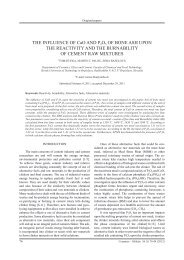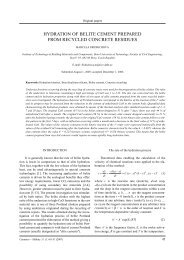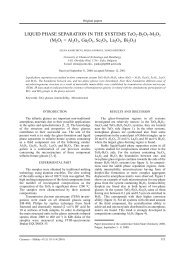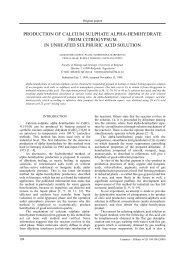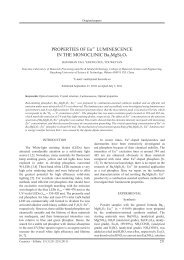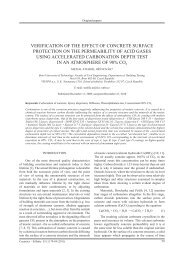TRIBOLOGICAL PROPERTIES OF CARBON ... - Ceramics-Silikaty
TRIBOLOGICAL PROPERTIES OF CARBON ... - Ceramics-Silikaty
TRIBOLOGICAL PROPERTIES OF CARBON ... - Ceramics-Silikaty
You also want an ePaper? Increase the reach of your titles
YUMPU automatically turns print PDFs into web optimized ePapers that Google loves.
DISCUSSION<br />
When measuring the time dependence of the friction<br />
coefficient, we must decide what is the importance<br />
of the sequential values and what values are the most<br />
characteristic for various samples. The average values<br />
of the friction coefficient are important, even though<br />
they do not characterize the time changes of the friction<br />
coefficient fully. We suppose that the most important<br />
friction coefficient value is the value after 250 turns.<br />
This value is taken after running-in, i.e., after grinding<br />
out most of the nodes and protrusions, and reaching<br />
some stable state. Thus, this value of friction coefficient<br />
is discussed in the following text. The lowest value of<br />
the friction coefficient is for the ground C–C composite,<br />
and the value is almost the same for unground C–C<br />
composite with a PyC layer. The differences between<br />
these values show that for the C–C composite a<br />
decrease in roughness decreases the friction coefficient<br />
by about 10 %, while in the case of the PyC layer a<br />
decrease in roughness increases the friction coefficient<br />
by about 30 %. The latter comparison is statistically<br />
significant, while the significance of the former is relatively<br />
low; the statistical significance was checked<br />
using the standard formula for Student test at significance<br />
level α = 0.05 [20].<br />
The data for friction and wear of PyC are very rare<br />
in literature. Our results agree generally with values for<br />
various DLC films in [21, 22]. In [21] amorphous<br />
hydrogenated carbon films were prepared using 5%<br />
C2H2, 95% H2. The hardness and roughness of those<br />
films was not given. Under vacuum conditions, the<br />
value of friction coefficient was 0.12 at the start of test<br />
which agree with our results (in air). After hundred<br />
turns it decreases to about 0.08 due to roughness effect.<br />
Again it agrees with our results (sets I, II, IV), even<br />
though the decrease of friction coefficient in our measurement<br />
was slightly lower (in average for about 0.01).<br />
The same shape of time dependence of friction as<br />
for our measurement (set III) was found in [2] for<br />
fretting wear. Fretting wear occurs when two contacting<br />
materials undergo a relative oscillating displacement<br />
(stroke 0.1 to 200 µm), as can be the case for machine<br />
parts. At the RF plasma-produced DLC coating (roughness<br />
Ra 0.17 µm, E-modulus (58 ± 5) GPa and hardness<br />
5 ± 1 GPa, with counterpart created by a polished<br />
corundum ball of 10 mm diameter), the wear rate was<br />
1.6×10 -7 mm 3 /Nm, which is comparable with our results.<br />
The increasing of fric-tion coefficient at set III is similar<br />
to a behaviour which given in [21], but the reason is<br />
unclear till now.<br />
The differences in the friction coefficient between<br />
the C–C and PyC surfaces are low for higher roughness<br />
and much more pronounced for lower roughness. This<br />
finding signalises the possibility of an increasing<br />
Tolde Z., Starý V., Kubart T.<br />
dependence of friction coefficient on material type in<br />
the case of a flatter surface, perhaps due to better contact<br />
between pin and surface materials when there is<br />
lower roughness. At higher roughness, the contact<br />
between the two materials during mutual movement is<br />
much interrupted by "skipping" of the pin on the surface<br />
asperities.<br />
As usual, the movement of the pin on a more or less<br />
rough surface causes slight instabilities of the friction<br />
coefficient, and this appears as measurement noise. The<br />
general time dependence of µ shows that for sets I, III<br />
and IV after a rapid increase the values stabilised (I and<br />
IV) or increased slowly (III). Only set II shows a steadily<br />
decreasing tendency. We suppose that these changes<br />
can be explained by greater grinding of the relatively<br />
smoother surface layer by the pin for set II than for<br />
set I, and by lubrication of the surface by carbon particles.<br />
In the case of set I, the particles stay among the<br />
surface protrusions and do not lubricate the area<br />
between pin and surface. Figure 3 also shows that, after<br />
the running-in period, the time dependence of µ is very<br />
similar for set I and set II. A similar explanation cannot<br />
be used for comparing set III and set IV, because their<br />
time dependencies are qualitatively different. We<br />
suppose that due to the higher hardness and the lower<br />
wear of PyC in comparison with C–C composites the<br />
lubrication for sets III and IV is lower. The relatively<br />
high roughness of the unground samples may change<br />
during the test, while the flatter surface changes only<br />
very little. It is also known that the friction coefficient<br />
of carbon materials depends on atmospheric humidity.<br />
Since the atmosphere was neither controlled nor<br />
checked in our tests, some differences of friction coefficient<br />
among the samples may have been due to different<br />
humidity in the tests. Even though we did not measure<br />
it, the temperature and atmospheric pressure during the<br />
tests were approximately identical, and we suppose that<br />
this influence was minimal in our test.<br />
While measuring, we were not able to measure the<br />
wear by sample weighing because, in contrast to our<br />
primary assumptions, the wear was very low and the<br />
obtained values were within the error level. Also, we<br />
had planned to use a glass or hard plastic sphere as the<br />
pin, but these materials were too soft to make a measurable<br />
path on both the C–C composite and the pyrolytic<br />
graphite. We therefore used the above-described experimental<br />
method. The best wear resistance was found for<br />
the samples of sets III and IV, i.e., for samples covered<br />
by PyC. This is mainly due to its high hardness, which<br />
is about twice higher than the hardness of the C–C composite.<br />
For both groups of samples (I and II, III and IV),<br />
there was almost no dependence of wear resistance on<br />
surface roughness. The differences in the groups (i.e.,<br />
between sets) were statistically insignificant. The calculation<br />
of the statistical agreement shows that the aver-<br />
42 <strong>Ceramics</strong> − Silikáty 52 (1) 37-44 (2008)



